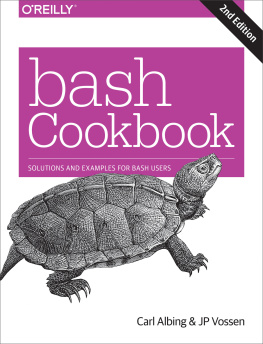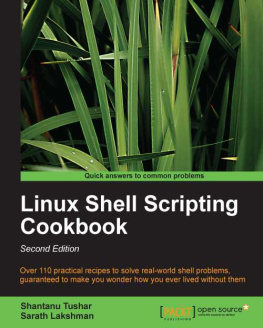JP Vossen - bash Cookbook, 2nd Edition
Here you can read online JP Vossen - bash Cookbook, 2nd Edition full text of the book (entire story) in english for free. Download pdf and epub, get meaning, cover and reviews about this ebook. year: 2017, publisher: O’Reilly Media, Inc., genre: Computer. Description of the work, (preface) as well as reviews are available. Best literature library LitArk.com created for fans of good reading and offers a wide selection of genres:
Romance novel
Science fiction
Adventure
Detective
Science
History
Home and family
Prose
Art
Politics
Computer
Non-fiction
Religion
Business
Children
Humor
Choose a favorite category and find really read worthwhile books. Enjoy immersion in the world of imagination, feel the emotions of the characters or learn something new for yourself, make an fascinating discovery.
- Book:bash Cookbook, 2nd Edition
- Author:
- Publisher:O’Reilly Media, Inc.
- Genre:
- Year:2017
- Rating:3 / 5
- Favourites:Add to favourites
- Your mark:
bash Cookbook, 2nd Edition: summary, description and annotation
We offer to read an annotation, description, summary or preface (depends on what the author of the book "bash Cookbook, 2nd Edition" wrote himself). If you haven't found the necessary information about the book — write in the comments, we will try to find it.
For system administrators, programmers, and end users, shell command or carefully crafted shell script can save you time and effort, or facilitate consistency and repeatability for a variety of common tasks. This cookbook provides more than 300 practical recipes for using bash, the popular Unix shell that enables you to harness and customize the power of any Unix or Linux system.
Ideal for new and experienced users alikeincluding proficient Windows users and sysadminsthis updated second edition helps you solve a wide range of problems. Youll learn ways to handle input/output, file manipulation, program execution, administrative tasks, and many other challenges. Each recipe includes one or more scripting examples and a discussion of why the solution works.
Youll find recipes for problems including:
- Standard output and input, and executing commands
- Shell variables, shell logic, and arithmetic
- Intermediate shell tools and advanced scripting
- Searching for files with find, locate, and slocate
- Working with dates and times
- Creating shell scripts for various end-user tasks
- Working with tasks that require parsing
- Writing secure shell scripts
- Configuring and customizing bash
JP Vossen: author's other books
Who wrote bash Cookbook, 2nd Edition? Find out the surname, the name of the author of the book and a list of all author's works by series.






![Cameron Newham [Cameron Newham] - Learning the bash Shell, 3rd Edition](/uploads/posts/book/119671/thumbs/cameron-newham-cameron-newham-learning-the-bash.jpg)

